 In
Search of Colombian Cobs
In
Search of Colombian Cobs 
A classic introductory article by Frank Sedwick
(First published July 1985 The Numismatist)
(NOTE: Some data might have
been proven different, this study was from 1985)
Cobs are an obscure area of
numismatics unfamiliar to most students of Spanish-American coinage, a fact that
comes as no surprise considering no two specimens of these hand-hammered coins
assume an identical shape, thickness or visible portion of imprint. The cob
coinage of Nuevo Reino, however, is even more mysterious and elusive than that
of the better-known Spanish colonial mints of Mexico, Bolivia and Peru.
Although more has been
learned about colonial cobs in the last 25 years than in the previous two
centuries, researchers have been unable to document enough facts to produce a
definitive reference about Colombian cobs. Without becoming too technical, it is
the purpose of the present study to summarize what is known so far about these
coins and to assess what has yet to be learned.

The Land of
Undiscovered Treasure
Spanish exploration of the
northern-most region of South America commenced about 1500. This territory
encompassed not only present-day Colombia, but also Venezuela, Ecuador and even
Panama, all of which were at one time part of Colombia. The Spaniards designated
the region as El Nuevo Reino de Granada, the “New Kingdom of Granada.”
The Indians called the settlement on the high plain Bacatá, which
conquistador Gonzalo Giménez de Quesada later renamed Santa Fe de Bogotá
in 1538.1
This was El Dorado, the land of undiscovered treasure, named for an Indian chief
who, according to legend, was annointed with gold dust and surrounded by gold
and jewels at Lake Guatavita near Bogotá. Though El Dorado was never found, gold
was indeed abundant in the area, waiting to be mined; silver was mined in small
quantities, but only as a by-product of gold extraction. This fact may explain
why all Colombian silver cobs are rare and why Nuevo Reino was the first
mint in the Americas authorized to produce gold coins.
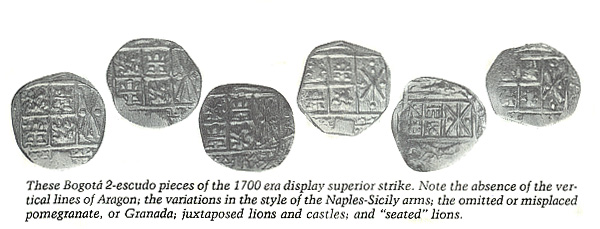
The Unique Nuevo
Reino Cobs
Whether gold or silver,
Nuevo Reino cobs are characterized by their crudity, inconsistency of design,
and cut. All cobs are crude, but, in general, the workmanship of Colombian cobs
of nearly all periods is inferior to that of Mexico, Peru and Bolivia. The
blundered strike is typical; legends are seldom visible, dates are rare finds,
and devices are poorly etched. Lines that should be straight are crooked,
especially on the gold pieces; tressures (heraldic borders) are unsymmetrical;
elements of the shields are out of proportion; castles look like stylized Indian
gods; and lions take on the appearance of monkeys balanced on their posterior.

Nuevo Reino, like other
Spanish-American mints, emphasized the shield-type obverse on its early silver
cobs, changing later to the “pillars-and-waves” design, but the variations are
astonishing. (All Nuevo Reino gold cobs, like all silver and gold Mexican cobs,
are of the shield type.) For example, the arms of Naples and Sicily2
should be located to the right of the lions and castles, but just as likely can
be found to the left, a position somewhat akin to displaying the U.S. flag on a
wall with the 50 stars in the upper-right corner instead of the left. Other
elements of the shield also are sometimes juxtaposed or omitted, such as the
vertical lines of Aragon’s coat-of-arms or the pomegranate (symbolic of
Granada), the latter often located at the bottom of the shield rather than in
the center.
Henry Christensen may have
been the first to point out the gradual disappearance of the Aragon arms, making
Nuevo Reino cobs unique in this respect.3 Also, the quadrants
featuring the two lions and two castles are reversed on Colombian cobs with
great frequency, a phenomenon not exclusive to the Bogotá mint but nevertheless
seldom encountered. In short, the ways in which the shield is depicted on
Colombian cobs reveal that the Nuevo Reino mint employed a number of independent
thinkers.
Colombian silver cobs of
the pillars-and-waves design display oddities, too. One cannot be sure where to
look for the date or denomination. The Nuevo Reino mintmark, NR, varies in
monogram as well as location, while the variant SF mintmark (for Santa Fe) can
appear as FS. Assayers’ initials tend to be multiple rather than single;
however, when single initials are used, they are sometimes mingled with the
mintmark, such as NER, or the mintmark itself may be backwards, as in RNE. The
pillars are usually fat and crude, and the legend PLUS ULTRA can be found in any
kind of nine-letter jumble between, above or around the pillars. The lions and
castles on silver cobs of larger denominations occasionally are well executed,
as evidenced by the 8 reales with N/E/R.
Cob authorities and
collectors of experience have identified a typical Bogotá “cut,” which is
representative of most periods but difficult to define. The angles are
uncharacteristic of the products of other mints; even when a Bogotá coin tends
to roundness, its cuts often are abrupt and do not flow into one another.
Especially on later gold of smaller denominations, the cuts tend to incline at
45-degree angles, perhaps because Nuevo Reino planchets usually were thick
rather than broad (the weight remained the same in either case). Their Mexican
and Peruvian counterparts (Bolivia produced no gold cobs) display a more-or-less
perpendicular cut.
Mints and Mintmarks
As early as 1559, efforts
were made to set up a mint in Nuevo Reino de Granada, but for one reason or
another, permission was not granted by the Spanish crown until 1620. At
the time, colonial mints were
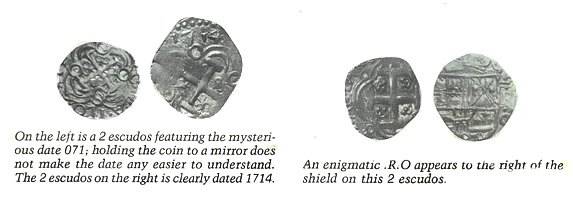 considered
to be private enterprises and were granted licenses to manufacture money by the
King of Spain. Mint offices—like those of mintmaster or assayer—could be
purchased, transferred or leased; the bidding for these posts was intentionally
competitive, almost like the sale of a seat on the New York Stock Exchange in
our time. The mintmaster owned the mint for life, or until he sold his
lease or was removed from office for malfeasance. Sometimes the mint’s
owner lived in Spain and never even saw his operation. Not until about
1762 did the Spanish treasury actually begin to take control of the colonial
mints.
considered
to be private enterprises and were granted licenses to manufacture money by the
King of Spain. Mint offices—like those of mintmaster or assayer—could be
purchased, transferred or leased; the bidding for these posts was intentionally
competitive, almost like the sale of a seat on the New York Stock Exchange in
our time. The mintmaster owned the mint for life, or until he sold his
lease or was removed from office for malfeasance. Sometimes the mint’s
owner lived in Spain and never even saw his operation. Not until about
1762 did the Spanish treasury actually begin to take control of the colonial
mints.
As dictated by Spanish
tradition, the chief assayer’s initial(s) was engraved on a die and struck on
the coin as part of its design, supposedly to guarantee accuracy of weight and
purity of gold or silver content. The initial(s) usually represented the
first letter of the assayer’s given name or either of his surnames.4
Records were kept of the assayers’ names and the dates of their tenure.
Although many are inaccurate or lost, these records are most important today in
identifying the approximate date of an undated cob.
Through the study of such
documents and a royal decree dated April 1620, it is known that Spain’s King
Philip III authorized Captain Alonso Turrillo de Yebra to establish a private
mint in the region of Nuevo Reino de Granada.5 Turrillo was torn
between locating his mint in Santa Fe de Bogotá or in the port of
Cartagena—either way, his precious cargo had to be transported on the Magdalena
River, through mountains and jungles, at the mercy of bandits between the
highland mining center and the coastal point of embarkation for Spain.
Ultimately, he managed to start minting operations in both locations. The
Cartagena facility, the smaller of the two, was characterized by sporadic and
ephemeral production, and probably operated until the mid-1600s. However,
it is a mystery as to which operation was established first and when, and
whether Cartagena produced any cobs other than known non-silver and non-gold
coins.
A partial answer came in
late 1978, when divers located wreckage of the Spanish treasure ship
Concepción, sunk in a storm in 1641 off the northern coast of what is now
the Dominican Republic. Heading for Spanish from Havana with the rest of
the fleet, the Concepción bore the usual Oriental and New World treasures
transshipped from other colonial ports, including Cartagena.
Her cargo was predominately
silver, mainly silver cobs from Mexico and Bolivia; however, one small group of
cobs bore NR or RN mintmarks, mostly with assayer’s initials P or A. In
this cache of Colombian silver cobs were several that featured the rare
assayer’s initial E, a few of which had NR mintmarks while others displayed C
mintmarks.
The C can stand for only
the Cartagena mint. Apparently assayer E, while in Turrillo’s employ,
moved from one mint to another. In the early days of numismatic analysis,
cobs bearing C mintmarks were attributed to the mints of Cuenca or la Coruña in
Spain,6 even though their mintmarks and coinage style were entirely
different from those of Colombian mints.
Other evidence supporting
the Cartagena theory—too lengthy and complex to summarize here—can be found in
Henry Christensen’s Auction Catalog of Treasures from the Concepción
(May 14, 1982),7 in which a handful of Cartagena cobs was offered for
the first time.
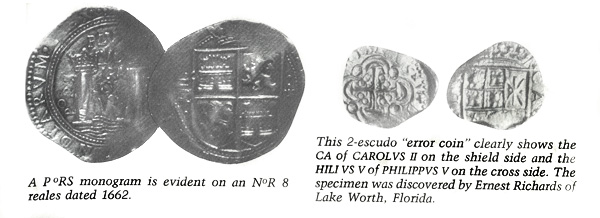
The
Mysterious Assayers
Colombian silver cobs
probably were produced at least into the 1720s, with gold cobs struck until the
mid-1750s. The list of assayers presented in Table 2 has been compiled
from various sources, as well as from personal experience. The dates
represent the assayers’ tenures of office as recorded by Barriga Villalba.8
Despite the fact that Barriga had access to all the official documents in
Bogotá, his dates sometimes conflict with assayer-date combinations on the
coins. He lists other assayers (omitted here) whose names do not seem to
correspond with any initials found on coins. Various dates of tenure also
differ in J. Pellicer i Bru’s Glosario de maestros de ceca y ensayadores.9
On the other hand, one whole run of 2 escudos of the early 1700s features
neither mintmarks nor assayers!
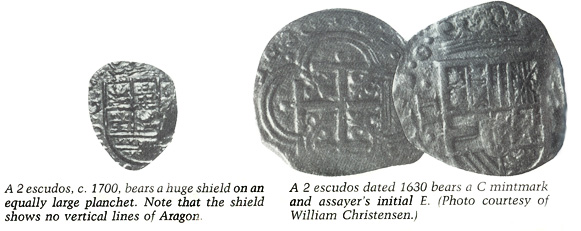
The Challenge of
Dating Colombian Cobs
Dates on larger
denomination Nuevo Reino cobs of the pillars-and-waves type are frequently
visible because of their location near the pillars rather than in the
haphazardly-truncated legend near the edge. On both
traditionally-monogrammed ½ reales and the shield types, dates are rarely found,
especially on smaller denominations.11
Despite what various
sources contend, almost any date or denomination is possible, from 1622 well
into the 1720s or beyond. The commonest dates appear to be around the
mid-1600s. No catalog provides a complete listing of dates, probably
because it has not been within any author’s experience to see or document more
than about 70 dates. However, an important hoard of silver cobs was found
in Colombia by Clyde Hubbard, a well-known authority on Latin-American
numismatics, and later analyzed by NeSmith in 1958.12
At this point it should be
reemphasized that Philip III’s aforementioned decree of April 1620, which called
for the establishment of a mint in Nuevo Reino, authorized the minting of gold
coins as well as silver. The Bolivian mint never produced gold cobs, and
the Mexican and Peruvian mints were not permitted to issue them until the late
1600s, after Colombian gold cobs had circulated for many decades.
Philip III died in 1621,
succeeded by Philip IV (designated on coinage as Philip IIII) whose long reign
lasted until his death in 1665. A 1622 2 escudos, apparently the first
gold coin of Colombia and the Americas, is illustrated in the 1985 edition of
Monedas españolas desde Juana y Carlos a Isabel II: 1504 a 1868
by Ferrán Calicó, Xavier Calicó and Joaquín Trigo.13 Bearing the SF
mintmark but no assayer, the coin was not listed or illustrated previously in
earlier editions of this prestigious reference (nor in any other book), thus
accounting for the note under the illustration: “Only specimen known and
for the first time pictured. The King’s numeral [III] quite clear.”
By its design and technical
workmanship, this great rarity is obviously of higher quality than all
subsequent Colombian gold cobs. Perhaps the dies were made in Spain (where
it was not known who was to be the assayer in Bogotá) and transported to the New
World during the lifetime of Philip III, whose numeral the coin bears.
This would explain why the coin—the only Nuevo Reino cob issued prior to
Philip IV—is listed in Calicó’s book under Philip III.
Although the months of
delay between the cutting of the dies in Spain and their slow transportation
across the Atlantic and inland to Bogotá is understandable, how can a 1622 date
be reconciled with a coin bearing the numeral of Philip III, who died in 1621?
Perhaps news of the king’s death had not reach Bogotá by the time the pieces
were minted. However, if they had the expertise to reengrave a date, why
couldn’t they also add an assayer? Maybe the date was not reengraved but
merely representative of Spain’s foresight as to when the dies would arrive in
the New World (a theory that seems farfetched). Calicó offers no
explanation.
Just last year, another
specimen of this rare 2 escudos came to light. A comparison between the
Calicó specimen and the second piece suggests both were struck from the same
dies; however, the latter is inconclusive as to the king’s numeral and lacks all
but a tiny, raised portion of the final digit of the date. The final 2 in
the date on the Calicó specimen also is raised higher than the first 2.
This observation, coupled with the fact that the pieces were likely struck from
the same dies, is evidence that the coins share the same date.
The Calicó piece gives no
evidence of a reengraved final digit, neither on visual inspection nor by
mention of the authors. Once again, if the present coin had been struck in
Bogotá with a reengraved final numeral after the year 1622, is it not likely
that the people at the mint also would have added an assayer’s initial?
Whatever the answer, these two coins must represent the earliest gold coins of
the Americas. Whether struck in Spain or Colombia, the coins possibly were
presentation pieces—two of a very limited few—and not intended for circulation.
Also known is a 1630 2
escudos (C mintmark, assayer E) that is too crude to have been produced in
Spain, yet Calicó shows a 1630 with clear C/E listed under Cuenca, Spain, and
has no listing for Cartagena gold. Despite Christensen’s analysis and
auction of Cartagena cobs in 1982, various prominent numismatists still seem
unconvinced that a mint was ever established in Cartagena.
In the possession of Henry
Taylor, a treasure salvor who lives in the Florida Keys, is a document from the
General Archives of the Indies in Seville, Spain, written in Old Spanish.
Dated August 31, 1630, the document outlines in detail the plans for a mint
building to be located in Cartagena on Calle de la Cruz, suggesting that the
Bogotá mint was established (in 1622, of course) before the Cartagena mint,
rather than vice versa, as most who accept the existence of the Cartagena mint
believe. But, who knows whether the document refers to the original
establishment of the Cartagena mint or to a new Cartagena facility replacing an
old one?
Less puzzling is an almost
entire run of Nuevo Reino 2 escudos dated between 1627 and 1663. Many 2
escudos of this style and its variants were represented in the so-called Mesuno
hoard,14 found in 1936 near the Colombian town of Honda on the banks
of the Magdalena River. Most of the hoard was comprised of 2-escudo pieces
bearing the NR mintmark and assayer’s initial A. No other Colombian gold
denominations
appear to have been minted during the reign of Philip IV (1621-65).
The original decree of Philip III authorized coins in denominations of 1 and 2
escudos, although I have not seen any 1-escudo pieces from this period.
Moving on to the reign of
Charles II (1665-1700), I am aware of no 8- or 4- escudo pieces, only a few
undated 1-escudo coins and a handful of 2 escudos dated between 1671 and 1699.
Though unrecorded in any book, the 1695 and 1699 issues do exist, as evidenced
by the 1699 2 escudos pictured here.
It seems that 4 and 8
escudos were first minted in small numbers in the 1740s during the second reign
of Philip V (1724-46) and during the reign of Ferdinand VI (1746-59) until 1756,
probably the final year of Nuevo Reino cob coinage. However, the 2 escudos
produced during the first reign of Philip V (1700-24) are another story.
These 2 escudos are now the
commonest Colombian gold cobs, although before the salvage of a 1715 Spanish
fleet sunk off the east coast of Florida (which began in the early 1960s and
continues even now) they were extremely rare.15
It might be wise to pause
for a moment to discuss the chronology of royal succession, which can be
particularly confusing for those who are unacquainted with Spanish history.
Charles II was king of Spain from 1665 to 1700, and Philip V reigned from 1700
to 1724, the year in which he abdicated in favor of his 16-year-old son, Luis.
Luis I died later that same year, whereupon Philip reoccupied the throne from
1724 until his death in 1746, hence the period known as his second reign.
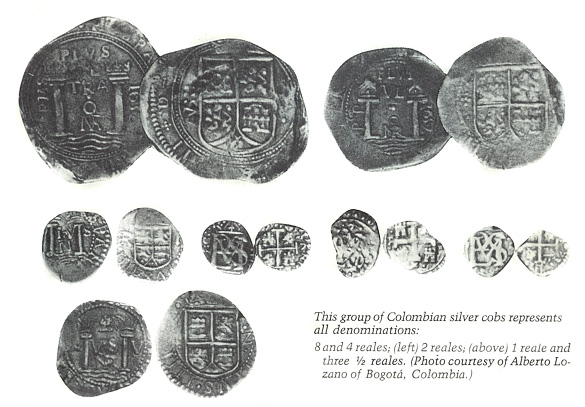
In a perplexing series of
events, Philip V, a Bourbon, was sponsored by the French and opposed by the
English, Dutch and Austrians, who in 1701 formed an alliance to replace Philip V
with the Archduke of Austria, who is known to history as the Pretender Charles
III (not the same as King Charles III of Spain, who reigned from 1759 to 1788).
Subsequently, a civil war, referred to as the War of the Spanish Succession,
broke out in Spain in 1702 and spread throughout Europe. In 1713 the
Treaty of Utrecht brought an end to the war and confirmed Philip V as king of
Spain and her dominions in the Americas, much to the chagrin of the autonomous
republic of Catalonia and its capital Barcelona, which had been aligned with the
Pretender.
Thus, listed in Calicó’s
Monedas
under Charles III, Archduke of Austria, is a group of Colombian 2 escudos dated
consecutively between 1701 and 1713 (with the exception of 1702), as well as
Colombian 8 reales of 1702 and 1705. No coins of the other New World mints
are included. The only logical assumption is that somehow the authorities
in Bogotá favored the Pretender and that the use of the legend CAROLVS (Latin
for Carlos or Charles) on Colombian 2 escudos was quite intentional, rather than
a result of a communication lag after the death of Charles II in 1700s. On
the other hand, I have yet to find CAROLVS followed by a III instead of a II on
these coins.
Calicó lists A as the
assayer for this group of 2 escudos dated 1701-13. I have seen hundreds of
these coins and have yet to find one with any visible assayer or mintmark, the
absence of which cannot be accidental. Not illustrated here, yet in my
possession, are several typical specimens on which the legend CAROLVS II D.G.
runs closely around the entire periphery of the shield, leaving no space
whatsoever for mintmark-assayer designations. Was this the Colombians’ way
of promoting the Pretender, using the legend CAROLVS well into the 1700s but at
the same time avoiding legal responsibility for doing so?
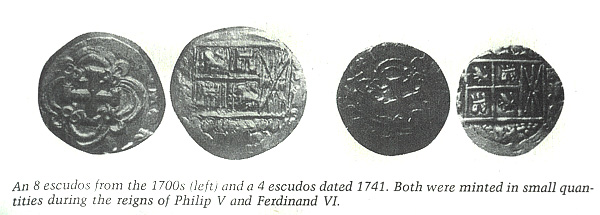
A Wealth of
Information
The sunken fleet of 1715
was laden with far more coins and treasure than usual due in large part to the
War of the Spanish Succession. During the conflict, the treasure fleet’s
semi-annual voyages from the New World had been curtailed or reduced to an
occasional few ships, causing coins to pile up in the colonial mints, from which
they could not be transported in quantity until after the Treaty of Utrecht.
According to the late W.
Frank Allen in his article “History Revealed: Previously Unknown Spanish Gold
Coins,”16 not only was Calicó aware of the work of the salvors of the
1715 fleet, but he also traveled to Florida in late 1964 to inspect the finds.
Thousands of Bogotá 2 escudos were salvaged, but only fourteen bore dates: 1672,
1687, 1697, 1701 (two specimens), 1703, 1704, 1705 (two specimens), 1707, 1708,
1709, 1712 and 1713.
Rarely does the date not
run off the planchet of Bogotá 2 escudos of this period, which spans not only
1700-15 but also the entire previous reign of Charles II, as evidenced by cobs
dating to the 1600s that were salvaged from the wrecks of the 1715 fleet.
Prior to this salvage, what had been particularly mysterious, however, was the
absence of Spanish-American gold cobs of the early-1700 period.
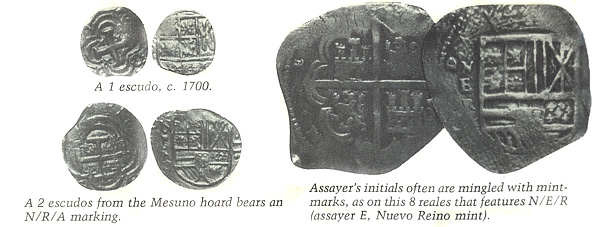
Calicó himself wrote the
preface for an auction catalog entitled
Spanish Galleon Treasure,
which offered the bulk of the salvaged material in a public sale conducted at
New York’s Waldorf-Astoria Hotel, November 27-29, 1972, by Schulman Coin and
Mint. To Frank Allen’s list this catalog added the 2-escudo dates of 1706
and 1710. A later Schulman auction held December 2-4, 1974, offered the
treasure from the
Maravilla, sunk
off the Bahamas in January 1656 (too early for most colonial gold coins, with
nothing significant in Colombian gold cobs), as well as a second and less
important offering of 1715-fleet coins, in which all the Colombian 2 escudos
were undated.
The material from the 1715
fleet later was offered publicly—and for the last time in quantity—in Bowers and
Ruddy’s Auction
Catalog of the 1715 Treasure Fleet,
February 17-19, 1977. In addition to the hundreds of descriptions and
photographs of original pieces, the catalog carries an entire section about
coinage of the Bogotá mint (though not all data are correct) and excellent
artistic renderings of various changes in design of the shield pictured on
Bogotá gold cobs. However, the catalog adds no new dates to the Hans
Schulman and Frank Allen lists of dated 2-escudo cobs.
To all the lists we can now
add a 1714 2 escudos. My own feeling is that all dates exist, 1700-14, but
I have no knowledge of a 1715-dated piece from the wreckage. Among the
salvaged Mexican gold cobs of all denominations, a number of 1715 pieces have
been found (very recently in quantity), although overall that date remains more
elusive than 1713 and 1714; among Lima pieces, it appears that 1713 was the
latest date on any denomination represented in the fleet’s cargo.
Remember, the fleet sank in
July 1715 with not more than a half-year of possible production of 1715-dated
coins. Why the Mexican coins of that year and at least some 1714-dated
Colombian cobs were available to be shipped with the fleet, while Lima pieces
were not, is unknown.
Through the years, I have
been privileged to examine hundreds of Colombian 2 escudos salvaged from the
remnants of these ships. Most of them have entered the market as the
property of the divers themselves or the investors in various salvage
enterprises. The State of Florida has a 25-percent share in any treasure
found off its shores and thus owns a quantity of these pieces, some of which are
displayed at the Museum of Florida History in Tallahassee.
A great majority of these 2
escudos shows some portion of CAROLVS II to the right of the shield, and
consequently it was logically assumed that most of those that sank to the bottom
of the ocean in 1715 actually were minted before the death of Charles II in
1700. However, we now have a different interpretation. In my
possession is a 2 escudos that features portions of CAROLVS by the shield on one
side and parts of PHILIPPVS or PHILIPVS V (the V is quite prominent) on the
other side where HISPANIARVM should be.
Although this is obviously
an “error coin,” the important feature is that the shield is the same as that on
most CAROLVS pieces, thus providing additional evidence that the typical Charles
II shield, even with his name beside it, was retained well into the 1700s, not
just a year or two after the death of Charles II but up to as late as 1714.
In short, the legend CAROLVS is not a reliable indication of when the coin was
minted.
Regarding coinage issued
after 1715, a Nuevo Reino 2 escudos of Luis I, dated 1725, does exist,17along
with numerous other Colombian cobs bearing dates of the second reign of Philip V
through 1756, the year that marked the end of Nuevo Reino cob coinage.
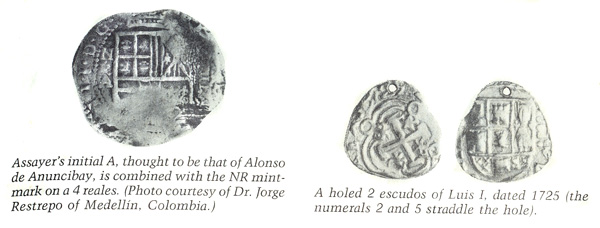
Unanswered Questions
(at the time of the
publication)
In the broad field of Colombian gold and silver cobs, a number of mysteries must
be solved:
-
We need to know the
entire story of the Cartagena mint. What were its years of production
and what was its specific relationship to the Bogotá mint? How many
other Cartagena gold cobs have surfaced in addition to the specimen pictured
here? Aside from the C mintmark, were early NR mintmarks also used in
Cartagena? Where exactly on the Calle de la Cruz was the mint, and why
are there no further records of its operations or construction, especially
considering that most colonial houses and buildings, or at least their sites
within the old walled city, are still intact, as are the walls themselves?
-
Where are all the
Bogotá silver cobs? Granted, production was not large compared to that
of Mexico, Bolivia and Peru, yet the most extensive collection I have seen
(which was in Bogotá) numbers only about 25 pieces. Who collects
Bogotá silver cobs? Please come forth and let us study your coins!
-
Why don’t official
records of assayers’ names and tenures, as listed by both Barriga Villalba
and Pellicer I Bru, correspond to each other or to actual dates on many
coins? Does the assayer’s initial T represent Turrillo himself, even
though he was the mint’s lessee and not its assayer? Who were assayers
E (both early and late) and VM? Was the late assayer A the same as
assayer ARC? If not, who was he? Why are asssayers’ initials so
often multiple, contrary to the practice of other colonial mints? Why
is the assayer’s initial omitted on what must be presumed to be the first
gold coin of the Americas, and where was this coin designed and minted?
-
Why did the Colombian
mints either omit or systematically relocate the pomegranate (or “Granada”)
on the Nuevo Reino de Granada coat-of-arms, when by the very name of the
province one would expect it to be prominent? Why did the Aragon
coat-of-arms gradually disappear from the king’s shield on most Colombian
gold cobs? Why were the positions of the lions and castles so often
juxtaposed?
-
Why were gold and
silver Colombian cobs so crudely designed and struck, when the labor
(untutored Indians) and equipment were hardly less primitive in the colonial
mints of Mexico, Bolivia and Peru?
-
What is the reason for
the frequent inversion of the SF mintmark, when FS (“Fe Santa”) makes no
sense? Likewise, one wonders about NR and RN, although “Reino Nuevo”
is linguistically easier to defend.
-
Why were so many 2
escudos but so few 8 escudos minted in Colombia, while in Lima the opposite
seemed to be true? (Mexico seems to have produced nearly equal
quantities of 2- and 8-escudo coins; 4-escudo pieces from all mints are
scarce.)
-
Did Colombia indeed
support the Pretender Charles III from 1702 to 1713? If so, does
Colombian coinage reflect this attitude?
Sunken Spanish galleons
await salvage off the shores of Cartagena today. The sites are known, but
requests for permission to explore the wrecks have yet to be worked out with the
Colombian government. With today’s advanced techniques of salvage,
reclaiming sunken cargo is no longer a vague, romantic adventure but a
scientifically- and economically-sound enterprise, if properly funded and
researched. Imagine what these ships could yield!
Hundreds of thousands of
unexamined, uncataloged bundles of inventories, ships’ manifests, reports,
charters, legal agreements and royal correspondence are held by the General
Archives of the Indies in Seville and the House of Trade in Simancas, Spain.
Treasure divers have sifted through some of this voluminous material, but has a
numismatic team of cob specialists done so? The answer is no. By and
large, treasure salvors are neither researchers nor numismatists, and frequently
discover the rarity of their finds only after the fact.
Given great patience, much
could be learned from the material in Seville and Simancas about cob production
and distribution in the New World, but who will fund such a venture? The
questions of funding aside, who will take the time to carry out such research?
Apparently, not even Spanish numismatists have done so.
Colombian Cobs and
the Numismatic Market
Colombian gold cobs are
vastly undervalued in the marketplace, as there are virtually no collectors to
compete for them. Much of the reason for this is the unavailability of
literature; most of what little does exist is written in Spanish.
Over the years, I have
spent much time in Colombia as a traveler and resident, but I have never met nor
heard of a serious collector of Nuevo Reino gold cobs. Not long ago, two
rare gold cobs of Bogotá came into my possession—a 4 escudos and an 8
escudos—and I almost gave them away for lack of a buyer. Undated 2 escudos
salvaged from the 1715 fleet are not hard to find and are sold mostly as
pendants, but collectors of dated 2-escudo cobs are as rare as the coins
themselves. A year ago the extremely rare Cartagena 2-escudo piece sold
for a relative song. As knowledge increases, this situation must change.
No informed collector
doubts the rarity of Colombian silver cobs. These pieces sell for much
more than Colombian gold cobs and comparable silver cobs of other colonial
Spanish-American mints, yet the market remains very small and suffers form a
scarcity of information, as in the case of Colombia’s gold issues.
When a famous American
financier was asked the secret to his success, his laconic reply was, “Buy a
straw hat in January.” Perhaps January is on the horizon, and Nuevo Reino
cobs will prove to be straw hats of the numismatic marketplace.
Biography:
Numismatic pioneer Frank Sedwick, Ph.D, was born in 1924 in Baltimore,
MD, and earned degrees from Duke University, Stanford University and the
University of Southern California. After a wartime stint in the Navy, Frank
became a career professor of Spanish and Romance languages, which he taught at
the Naval Academy, Ohio Wesleyan, Wisconsin-Milwaukee and finally Rollins
College in Winter Park, FL. At Rollins, while earning royalties as the author of
several standard textbooks in the field, he took the position of Director of
Overseas Programs and made frequent visits to Spain and Colombia, where his
interest in Latin American numismatics began, although coins had been his hobby
since childhood.
In 1981 Frank
left academia forever and became a full-time coin dealer. At first his focus was
modern Latin American coins, but soon he realized that there was a niche in
cobs, which had not been properly researched for the average collector to
understand and appreciate. Thus was born The Practical Book of Cobs (now
in its 4th edition, 2007), which was perfectly timed to satisfy new cob
collectors generated by the fabulous Atocha find by Mel Fisher in 1985. For well
over a decade Frank was considered the authority on cobs, his main area being
gold cobs from the 1715 Fleet, thousands of which went through his hands.
In 1991
Frank authored his second numismatic book, The Gold Coinage of Gran Colombia,
in order to update the existing references in his own area of collecting
interest. Frank's collection of Colombian Republic gold coins is still one of
the finest ever put together
Frank's son
Daniel joined him in business after college in 1989, full time in 1991, after
many summers of "interning" with him at the various ANA shows. In 1996, with
plans to retire that same year, Frank died unexpectedly, leaving the business to
his son. Daniel has continued the coin business and book authorship ever since.

